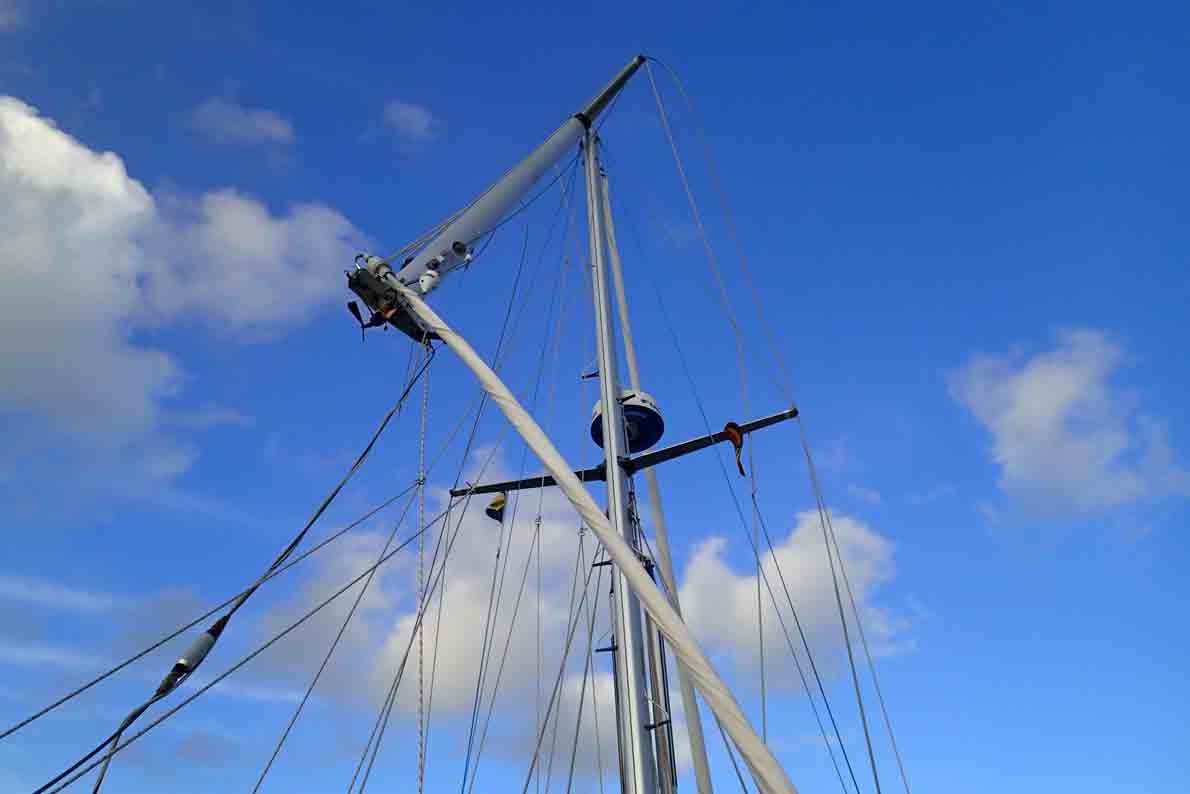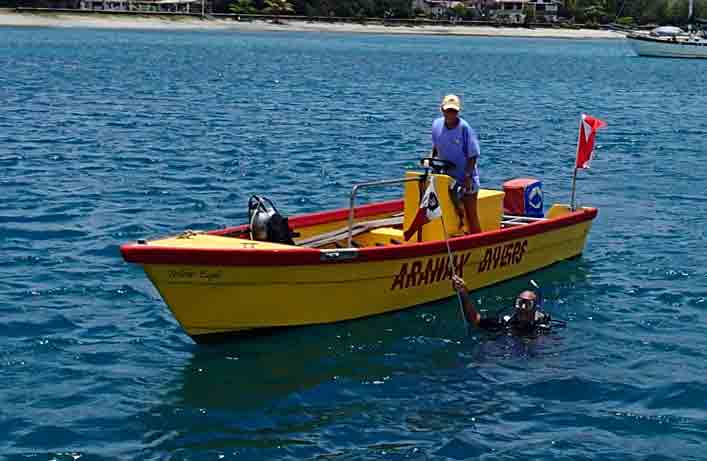Oriole trashed!

Oriole
Sun 6 Apr 2014 20:29
|
Tyrrel Bay, Carriacou,
Grenada.
Sunday 6th
April 12:27.48N
061:29.13W
It is difficult to describe one's feelings as a
steel leviathon comes thundering towards your anchored yacht as you sit quietly
at anchor sipping your afternoon tea eulogising about this delightful, quiet and
friendly place. There was a moment of severe anxiety and initial
parallysis and I will never forget Chris screaming, in a most uncharacteristic
way, "NO! NO!" as the ferry, returning to Tyrrel Bay, went out of control
as it turned to dock. Poor Oriole is in a
bad way and we feel we have let her down through no fault of our own. Oriole has
been our well maintained pride and joy for 18 years and it is distressing that
an episode of extraordinarily bad seamanship by the ferry crew has come so close
to sinking her and doing major and as yet incompletely assessed damage.
Our initial shock has now turned to anger and frustration. However we are
planning to go south to Grenada this week and hopefully to Trinidad next
weekend. We will have to motor and we anticipate being able to set the
staysail on the remaining bit of the mast. There follows an account of the
collision and the aftermath. We emphasise that we are fine and
unhurt. We are enormously grateful to all our friends here who have helped
us with advice and physical help in sorting out the mayhem and lowering the
severed end of the mast to the deck. We have also had several offers to
buddy boat us to Grenada and Trinidad. The surveyor from Grenada, who we
know, is due in Tyrrel Bay to assess the damage tomorrow morning.
Oriole Accident Report.
On Thursday afternoon 3rd April at approximately 1700 local time the Amelia
A3 approximately 150 foot steel ferry was returning to her normal berth in
Tyrrel Bay, Carriacou, Grenada, from which it had departed about an hour
previously. The ferry, a former Norwegian fjord ferry now registered in
Kingstown, St Vincent. Oriole was anchored towards the north side of
the yacht mooring and anchorage area and from the cockpit we observed Amelia A3
turning to go astern towards the ro-ro dock about 150 yards away. However
she did not complete the turn and continued astern towards Oriole. We
watched as the ferry came back towards Oriole and could see there was no one on
the stern of the vessel to observe where she was going. We were looking to
see the moment she started to go forwards to continue the turn, but she kept
coming astern. It became painfully apparent that she was going to continue
towards us. Eventually a horror struck face appeared at the top of the ramp
which was partially lowered. At this stage we had our engine going and
were attempting to motor forward to avoid or minimise the now inevitable
collision. However we were too late and the ferry hit the port side
of Oriole amidships where the toe rail was splintered and the stanchions bent
inwards and simultaneously the ramp caught the backstay and ripped the forestay
out of the stem head fitting and the top 10 foot section of the mast fell
down. The yacht heeled to around 45 degrees and the skipper and mate
abandoned ship into the dinghy as they feared the yacht might be pulled right
over. We observed the mayhem for a few minutes and then returned on board
Oriole to assist the crew of the ferry to disentangle Oriole's backstay
from the ferry's ramp. Once freed from the anchored yacht, the anchor of
which appeared to have held, the ferry with its engine stopped continued
to drift amongst the anchored and moored yachts until it managed to lower its
own anchor. Other yacht crews having seen what was happening to Oriole
moved yachts out of the way of the ferry leaving a large area which was
previously filled with anchored boats. Oriole then moved to the dock with a view
to lifting the damaged mast with the crane, and to allow the ferry space to be
towed and warped back to the ferry dock. We were told that the engines of
the ferry had jammed in astern gear and that they had needed to stop the engine
itself after the impact. In the event the crane was not
available.
Oriole's severed section of mast was being prevented from descending to the deck by its internal halyards and wiring and the foil of the jib furler, which was holding it away from the remaining, still standing lower section of the mast, but was swinging dangerously. The skipper climbed the mast and with hydraulic bolt cutters, cut the top of the forestay and it was then possible to lash the former top end of the mast to the remainder to stabilise it. The detached foil was lashed to lifelines along the starboard side of the yacht. It was well after dark around 1900 that Oriole was re-anchored for the night. On Friday morning three fellow yachtsmen helped the skipper and mate to lower the severed section of mast and clear away the tangled rigging and make the rig secure, an operation which took most of the day. It became quite clear that this would have been extremely difficult impossible to achieve without the use of Oriole's hydraulic wire/bolt cutters which enabled the skipper to cut the 9 mm rigging while aloft. Long lever type cutters would have been impracticable. An assessment of the damage while Oriole was alongside the dock revealed that the hull appeared sound and not making water into the bilge. All the deck gear at the stern was mangled - stern pulpit severely bent, wind generator pole bent with GPS antenna and wind generator torn off it, satellite communication antenna torn off and it's mounting pole bent, backstay tensioner bent, Hydravane wind steering system bent, outboard motor storage bracket badly cracked, gas BBQ mounted on the stern rail partially torn from its mounting, life belt and mounting bracket torn and bent, danbuoy severely bent, backstay chain plate bent and the teak toe rail splintered, ensign staff broken in two. On the port side three stanchions were severely bent and the teak toe rail which must have absorbed a lot of the impact was splintered from amidships towards the aft end. The foil of the jib furler was bent. As the furler fell it broke the outboard motor tiller mounting, and starboard side boarding ladder. At this stage it appears that the hull is sound and that the massively strong hull to deck bond has not been disturbed. The skipper and mate were severely shocked but physically unhurt. They think that if the only partially successful avoiding action had not been taken that the ferry would have hit the entire port side of the yacht which would have been trapped under the ferry ramp, and possibly completely rolled over and sunk. As it was the impact was at the aft half of the yacht. At no stage was there any warning given from the ferry that it was out of control, either vocally from its stern or via VHF radio. There was no lookout on the stern until moments before the impact. It is now apparent that the brief voyage from Tyrrel Bay was to test the engine. A diver later retrieved the Oriole's masthead burgee and mounting stick which had been torn off together with other damaged parts of the masthead gear. The wind generator was also sighted but not recovered. There was no sign of the mate's missing teacup!  Amelia A3 now anchored close astern
with her engines stopped. Imagine this monster coming hard astern straight
at you out of control!
 The dangling upper section of the mast
before we cut away the white sail covered foil. The wires from the upper
spreaders had to be
cut aloft before we could
lower the swinging loose section to the deck.
 Everything on the stern has been bent
and mangled
 Mercifully the contents of the cockpit
which included us were spared as the ferry hit,
otherwise we would have lost the
bimini, binacle, wheel etc. and would have been totally disabled.
 How many times has this toe rail been
lovingly varnished?
 On a lighter note, George and Connie
retrieved the RCC burgee from the bottom of Tyrrel Bay!
 Looking a little stubby and still some
minor adjustments, but essentially ready for sea.
|